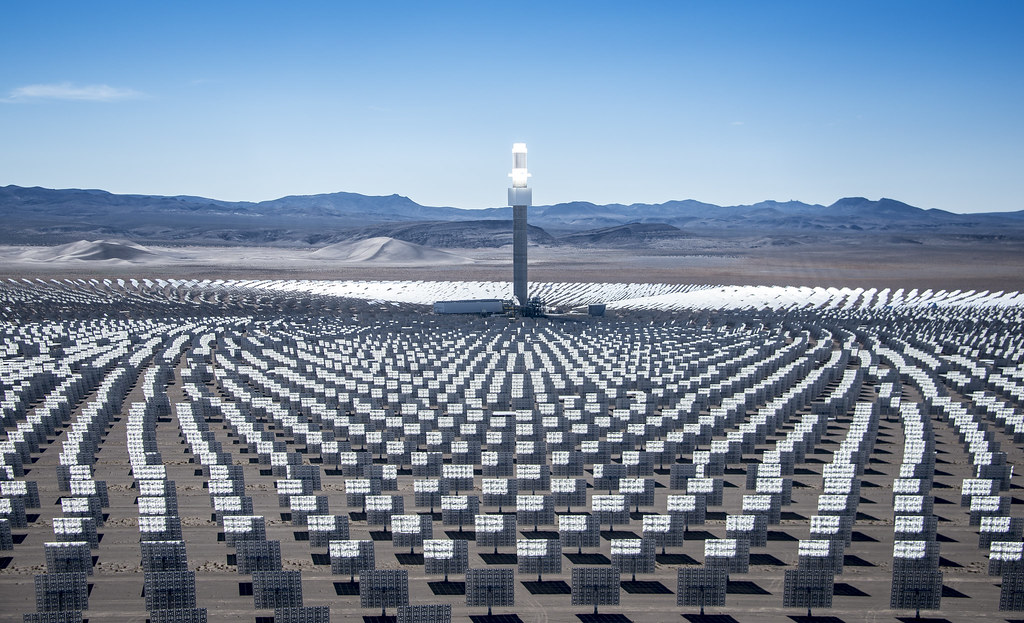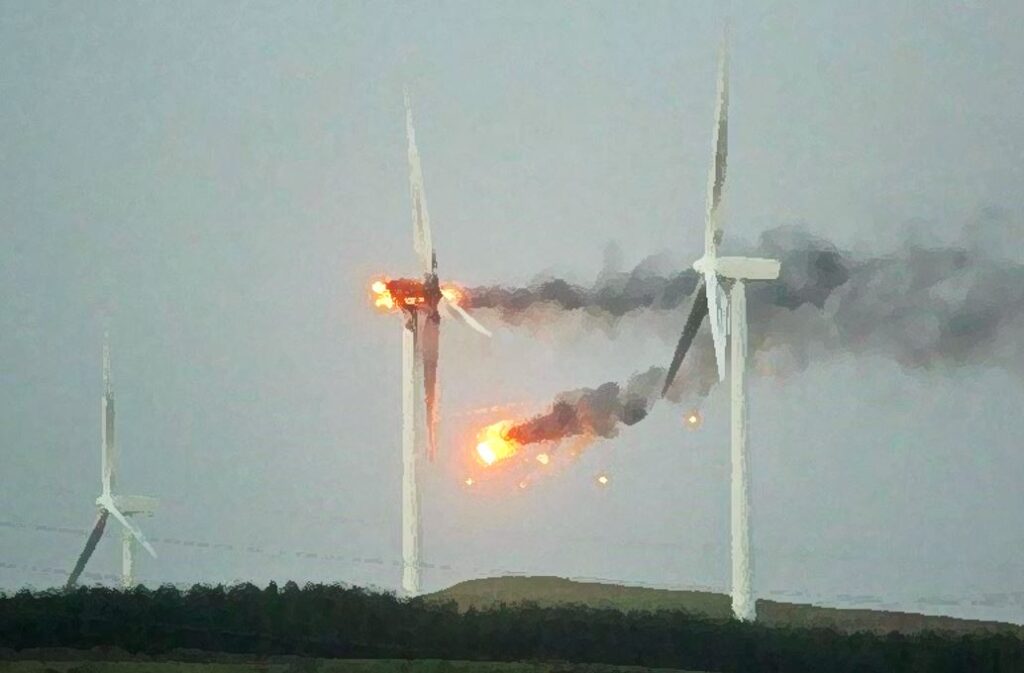This is a scientific report published by Thomas A. Troszak published in 2019
The link to the original PDF is here
Why do we burn coal and trees to make solar panels?
Thomas A. Troszak (2019/11/14 revision)
Why do we burn coal and trees to make solar panels? Thomas A. Troszak (2019/11/14 revision)
1. Most commercial solar PV modules use photovoltaic cells (solar cells) made from highly purified silicon (Si).
Since the early 1900s, silicon “metal” is reduced from quartz using carbon in submerged-arc furnaces, each powered by up to 45 megawatts* of electricity. (Fig 1,2)
2. Why do we need to burn carbon to make solar PV? – Elemental silicon (Si) can’t be found by itself anywhere in nature. It must be extracted from quartz (SiO2) using carbon (C) and heat (from an electric arc) in the “carbothermic” (carbon+heat) reduction process
*45 megawatts (MW) is enough for a small town (about 33,000 homes).
3. Even more fossil fuels are burned later, to generate electricity for the polysilicon, ingot, wafer, cell, and module production steps shown. [21] As a result of all these processes, the solar PV industry generates megatons of CO and CO2. But as shown below (fig 4), some often-cited descriptions of solar module production omit the raw materials and smelting process from the PV supply chain which obscures the use of fossil fuels and the vast amount of deforestation necessary for solar PV production. [1][3][9][27]
4. Raw materials for metallurgical-grade silicon
Raw materials for one ton (t) MG-Si (Kato, et. al) [37]
● Quartz 2.4 t
● Coal 550 kg
● Oil coke 200 kg
● Charcoal 600 kg
● Woodchip 300 kg
Raw materials for one ton (t) MG-Si (Globe) [3]
● Quartz 2.8 t
● Coal 1.4 t
● Woodchips 2.4 t
For 110,000 tpy (tons per year) MG-Si (Thorsil) [1]
● Quartz 310,000 tpy
● Coal, coke and anodes 195,000 tpy
● Wood 185,000 tpy
● Total 380,000 tpy
5. Sources of carbon for solar silicon smelting
• Coal – Is a dense, rock-like fuel. The (low ash) coal used directly for silicon smelting is mostly the ”Blue Gem” from Cerrajón, Columbia, Kentucky, USA, or Venezuela. [1][2][3][5][6][7][8]
The Cerrajón open-pit mine in Columbia supplies “Blue Gem” coal for silicon smelters around the world.
A ”Slot Oven” discharging coke into a railroad car. (photo: Alamy)
• Metallurgical Coke (Metcoke) is a tough, cinder-like solid fuel made by “coking” coal in large “slot ovens” – to drive out most of the volatile tars, etc. to the atmosphere as smoke, flame, carbon monoxide, carbon dioxide, sulfur dioxide, other gasses, and water vapor.
The coking process is nearly identical to the process used for
making charcoal from wood (see charcoal production
below). Restricting the air supply to a large mass of burning coal allows about 40% of the coal to “burn off” – leaving behind a solid residue (coke) with a higher carbon content per ton that the original coal. It takes about 1.6 t of coal to make a ton of coke.
Metcoke looks like porous, silvery grey coal.
Filling barges with petcoke outside Chicago, Ill, USA (photo)
• Petroleum Coke (Petcoke) – is a solid fuel in the form of pellet-like granules, which are a carbon-rich byproduct of crude oil refineries. Millions of tons of petcoke are also made directly from raw bitumen (tar). Due to its low price and high carbon content, petcoke made in American refineries from “Canadian Tar Sands” is a source of carbon exported from the U.S. to silicon manufacturers in China. [9]
“Beehive” charcoal ovens in Brazil (Alamy)
• Wood Charcoal – Many hardwood trees must be burned to make wood charcoal. In the traditional process, wood is stacked into “beehive ovens”, ignited, then mostly smothered to
prevent the wood from burning completely to ash. By weight, about 75% of the wood is lost to the atmosphere as CO, CO2, smoke, and heat.
In Brazil, it is estimated that more than a third of the country’s charcoal is still produced illegally from protected species. [14] Brazil is a charcoal supplier to silicon producers in other countries, including the United States. Silicon smelters around the world use charcoal from many sources, so solar silicon may be smelted with charcoal made directly from rainforest not grown on plantations.
This hardwood forest in the U.S. was clear cut to make wood chips
6. Hardwood Chips (also called Metchips) – Matchbox-sized fragments of shredded hardwood must be mixed into the silicon smelter “pot” for many reasons – to allow the reactive gasses to circulate, so
the liquid silicon that forms can settle to the bottom for tapping, and to allow the resulting CO (and other gasses) to escape the smelter “charge” safely. [4]
Solar silicon quartz rocks (Wacker Chemie)
7. Silicon ore – Quartz – (silica, silicon dioxide, SiO2) Even if sufficiently pure, silica sand won’t work in any silicon smelter, it is too fine. Selected high-purity quartz is mined and graded into “lumpy” (fist-sized) gravel for smelting. Worldwide, “solar grade” deposits of quartz are somewhat scarce, and highly valued.
A single polysilicon plant like this one in Tennessee, USA. can draw 400 megawatts of electricity, enough power for about 300,000 homes. (Wacker Polysilicon)
8. Polysilicon production
Metallurgical grade silicon (mg-Si) from the smelter is only about 99% pure, so it must undergo two more energy-intensive processes before it can be made into solar cells. First, the Siemens Process converts (mg-Si) from the smelter into polycrystalline silicon (called polysilicon) by a high-temperature vapor deposition process.
This is a bit like “growing rock candy” on hyper-pure silicon “strings” inside a pressurized-gas filled “bell-jar” reactor. As a mixture of silicon gas (made from mg-Si) and hydrogen gas passes through the reactor vessel, some of the silicon gas molecules “cling” to the electrically heated “strings” (called filaments) causing them to grow into “rods” of 99.9999% pure (or better) polysilicon.
Each batch of polysilicon “rods” takes several days to grow, and a continuous, 24/7 supply of electricity to each reactor is essential to prevent a costly “run abort.” So polysilicon refineries depend on highly reliable conventional power grids, and usually have two incoming high-voltage supply feeds.
A polysilicon plant consumes ~1.6 – 6 t of incoming mg-Si, and requires at least 175 MWh (or more) of additional electricity per ton of polysilicon produced – about 10 times the energy already used for smelting each ton of mg silicon from ore. [11] After the rods are removed from the reactor, they are sawed into sections or broken into “chunks” for loading into crucibles in the next step.
Polysilicon rods and sections being broken into chunks by hand in a clean room. (Hemlock)
Polysilicon chunks being heated in a crucible. When melted, a single crystal will be pulled out of the liquid polysilicon. (Getty)
9. Crystal growing (ingot production)
For making single-crystal solar cells (called mono PV) the PV industry uses the Czochralski process to further purify the polysilicon, and align the silicon molecules into a single-crystal form.
First, polysilicon chunks are melted in a rotating crucible in an inert atmosphere. Then a small seed crystal of silicon is lowered into the molten polysilicon. As the seed crystal is slowly withdrawn, a single silicon crystal forms from the tip of the seed. As the crucible turns, the polysilicon continues to grow into a cylindrical ingot, leaving most of the non-silicon impurities behind in the 5-10% of “pot scrap” remaining after the crystal is drawn free.
This process requires several days, and uninterrupted power. An ingot/wafer/cell plant can use more than 100 MWh additional energy per ton of incoming polysilicon, about 6 times as much as the original smelting of the silicon from ore. After slow cooling, the ingot’s unusable crown and tail are cut off (about 10%), the center is then ground down, the four “chords” (long sides) are sawn off (about 25%) leaving a rectangular “brick” so the solar wafers will be almost square after slicing.
For multi-crystalline cells (called multi PV) polysilicon is melted in rectangular quartz molds, then allowed to cool slowly into a rectangular ingot of multi-crystalline silicon. which is trimmed to remove unusable portions, then sliced into bricks.
10. Wafer sawing
Then, like a loaf of bread, the silicon “bricks” are sliced with wire saws into thin wafers, which will later be processed into cells.
About half of the “brick” is lost as “sawdust” in the wafer slicing process, and this can’t be recovered. So, after all of the energy and materials that have gone into making each “brick”, much of the incoming polysilicon does not ever become finished wafers. Some of the heads, tails, chords, and trimmings can be etched (to remove contamination) and remelted using additional energy if the purity of the scrap is sufficient to justify the expense, otherwise they are discarded as waste.
11. Cell and module production.
Once the wafers are sliced, they are made into “cells” by adding layers of other materials and components in a series of additional production steps.
Then the cells are assembled into modules. Beside silicon wafers, most solar PV modules also require many other energy-intensive materials – aluminum (for the frame), silver, copper, glass, plastic, highly toxic rare earth metals, acids, and dozens of other chemicals for processing the polysilicon into cells and modules. A lot of electricity is needed to power the cell production and module assembly, a supply of natural gas is used to provide heat in the process.
12. Other materials and steps
Once the modules are made, the whole PV system usually needs steel or aluminum framing, concrete, and some empty land (or a rooftop) to position it securely toward the sun, a lot of wiring to connect (through DC/AC inverters and transformers) to the existing power grid, or directly to battery banks,
Of course, it takes a lot of energy and resources to make steel, aluminum, concrete, inverters, copper wiring, and all of these other materials. In many cases, the “balance of system” components in a PV installation can require as much (or more) “up-front” resources and energy to make as the modules. [21]
In addition, the amount of fossil fuels and non-renewable resources needed to construct and maintain new PV production infrastructure (smelters, polysilicon refineries, etc.) is considerable, but has been excluded from all “life cycle analysis” (LCA) of solar PV production by definition. [38]
13. Transportation
Throughout the solar PV manufacturing process all of the materials and products must be shipped to and from more than a dozen countries around the world in large barges, container ships, trains, or trucks – all powered by non-renewable oil. [36]
14. Power
Worldwide, only a few silicon smelters, like those in Norway, are powered primarily by hydro-electricity. Elsewhere, the current majority of smelters, polysilicon refineries, ingot growers, cell and module factories are running on grids powered mostly by fossil fuels and uranium. At present, more than 50% of all solar silicon is made in China, where the industrial grid is powered largely by fossil fuels, primarily low-grade coal.
Depending on the “energy mix” available, the quantity of coal, coke, or gas that is being burned to deliver
power 24/7 to the PV factories may be far greater than the amount needed as the carbon source for smelting silicon. To provide a realistic assessment of the total environmental impact of PV manufacturing, this must be added to the “fossil fuel bill” for solar PV production – along with the “embodied energy“ of PV factories. [11][12][21]
15. Conclusions
Every step in the production of solar photovoltaic (PV) power systems requires a perpetual input of fossil fuels – as carbon reductants for smelting metals from ore, for process heat and power, international transport, and deployment. Silicon smelters, polysilicon refineries, and crystal growers around the world all depend on uninterrupted, 24/7 power that comes mostly from coal and uranium. The only “renewable” materials consumed in PV production are obtained by deforestation – for wood chips, and by burning vast areas of tropical rainforest for charcoal used as a source of carbon for silicon smelters. So far, both media and journal claims that solar PV can somehow “replace fossil fuels” have not addressed the non-renewable reality of global supply chains necessary for mining, manufacturing, and distribution of PV power systems. Based on current world production levels of solar PV, an attempt to replace conventional electricity production with solar PV would require a dramatic increase in the amount of coal and petcoke needed for silicon smelting, along with the increased cutting of vast areas of forest for charcoal and wood chips.
Readers are encouraged to examine all of the references
below, to become aware of other aspects with solar pv manufacturing and deployment that are beyond the scope of this paper.







References included in original PDF




